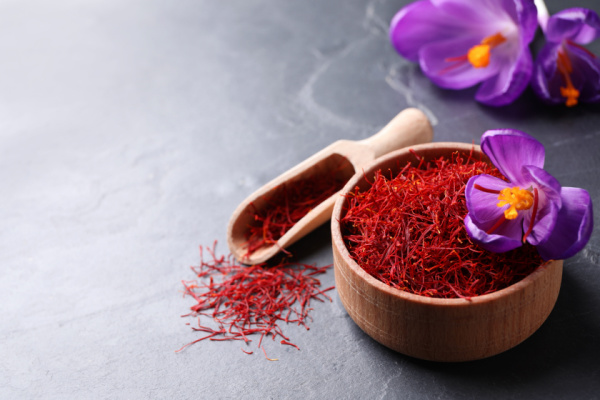If you’re making paella and you reach for a bottle of saffron, you could be grabbing something that’s exceedingly valuable, costing more than $5,000 per pound. Or you could be reaching for something fake. Yes, it’s not uncommon for the spice labeled as saffron to be something other than the fragrant spice that’s been traded and sought after for thousands of years.
Real saffron comes from the strands, or “stigmas” of the autumn crocus (Crovcus Sativus) flower. While the flower is purple, the stigma is red. Each crocus bulb produces only one flower and each flower only produces 3 stigmas. As a result, the spice is difficult to harvest and expensive to purchase.
As Business Insider reports, farmers in Kashmir take two years to grow flowers and harvest them, needing 170,000 flowers to yield a a pound of saffron, which is worth about $3,000. It’s a labor-intensive process, in which stigmas must be removed by hand, snipped, and sorted. This enormous price tag sets the stage for unscrupulous people who would pass off less costly materials as the precious spice.
The Kashmiri government has even introduced a trading center with a geographical indicator (GI) tag to certify authenticity. Fake saffron can be adulterated – mixed with corn silk threads, safflower (an unrelated thistle), coconut filaments or even dyed horse hair, or shredded paper. It can even be sprayed with water to make it heavier (and therefore costlier) by weight.
As with caviar, a water test can reveal what’s real and what is fake: real saffron slowly releases a yellow color into the water, while the yellowing is almost instant with artificial versions. Real saffron also disintegrates easily, while fake stays intact after wetting.
6 Tests You Can Do to Test Whether Your Saffron is Real or Fake (from motherwouldknow.com)
- Smell – Many authorities describe the smell of saffron as sweet. I would say it reminds me of paella – a distinctive smell that is not entirely sweet. Rather, I find it both sweet and husky. It is no surprise that saffron brings paella to mind. That dish include saffron in the rice and the addition of the spice gives paella an unforgettable aroma. For examples of how to use saffron in paella rice, check out this seafood paella or this chicken, mushroom and shrimp paella, both from José Andres. One saffron producer describes the aroma of real saffron as “a blend of earth, tobacco, vanilla, honey, salty sweet.”
- Appearance – Saffron threads are trumpet-shaped. If a thread does not bulge at one end, it’s a fake. If you rub real saffron between your fingers, your skin will turn yellow/orange.
- Taste – While saffron smells sweet, it tastes slightly bitter, not sweet.
- Time for color release in water – Put the threads in a small container of tepid water. Wait at least 15 minutes. Real saffron slowly turns the water yellow. The color change may take up to an hour. The saffron threads themselves retain their red color. If the water changes color immediately or turns red or does not change color, or if the threads lose their color, the substance is not saffron. As you can see, the Hungarian “saffron”did not color the water. That was a sure sign it was not real. Also, after they soak, real saffron threads will remain intact if you rub them between your fingers. Fakes on the other hand, tend to fall apart.
- How it reacts in baking soda – Several authorities suggest mixing saffron and baking soda in a small container, then pouring water over the mixture. If it turns yellow, the substance is real saffron.
- Price – If it is not too expensive, there’s a good chance it is not real saffron. If it seems too good to be true, then it probably is (too good to be true.) “Paying more for products does not assure their validity, but paying less kind of assures their invalidity — you’re not going to get cheap saffron,” says travel and food columnist Larry Olmsted.
Tips for Buying Saffron so You Don’t Get Duped
- Never buy ground saffron. Although your recipe may call for ground, if you buy it in threads, at least you can figure out if it is real. Once the substance is ground, it is almost impossible to distinguish real from fake or adulterated. Plus ground saffron, even if real, can contain fillers such as dyed rice flour, starch or other spices such as turmeric or paprika.
- Maybe it goes without saying, but it never hurts to remember that you should buy from a reputable source. That source can either be a store you trust or an online seller you have vetted.
It’s Important to Store Saffron Properly
You just spent a lot of your hard-earned paycheck on a spice. So do yourself a favor and make sure you store the saffron properly so it doesn’t lose its flavor (and you don’t lose your investment).
- Store saffron threads in glass in a cool, dark place.
- Do not store saffron in a plastic container or bag.
—
Photo Credit: New Africa / Shutterstock.com
